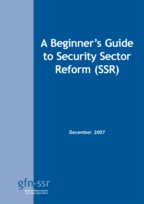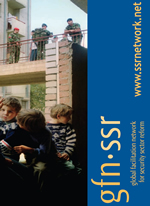Weapons reduction and disarmament, demobilisation and reintegration
High levels of armed violence in both conflict-affected and ostensibly peaceful societies are often a sign of a weak security sector. In countries where the government cannot provide security for the population, recourse to arms is widespread. In these cases, violence can become a way of life and a means of making a living. The resources on this page consider the design and effectiveness of programmes to integrate ex-combatants into society and to reduce the availability of small arms and light weapons in developing countries.
Page contents
- Where is a good place to start?
- Managing small arms and light weapons (SALW)
- Disarmament, demobilisation and reintegration (DDR)
- What other resources are available on the GSDRC?
- Additional information resources
Where is a good place to start?
Small Arms Survey, 2005, ‘Managing ‘Post-Conflict’ Zones: DDR and Weapons Reduction’, Chapter 10 in ‘Small Arms Survey Yearbook 2005: Weapons at War’, Small Arms Survey, Geneva
How effectively have disarmament, demobilization and reintegration (DDR) programmes and weapons reduction initiatives managed the transition from war to peace in post-conflict societies? How can future interventions maximise the chances of securing peace? This chapter from a work published by the Small Arms Survey examines the history of DDR and weapons reduction programmes to identify lessons learnt during past interventions. It argues that future programmes need to exhibit clearer objectives, better co-ordination and improved integration into broader political and developmental reforms.
Managing small arms and light weapons (SALW)
The widespread availability of small arms and light weapons provides a market for arms trafficking, facilitates corruption, and prevents the security sector from functioning effectively. Programmes to reduce armed violence aim to take weapons out of circulation and restrict their supply to help break this cycle.
The following two documents outline the UK government’s approach to managing SALW.
2004, UK Policy and Strategic Priorities on Small Arms and Light Weapons
Access full text: available online
Department for International Development, 2003, Tackling Poverty by Reducing Armed Violence. Recommendations from a Wilton Park Workshop 14-16 April 2003, DFID, London
Although armed violence poses significant obstacles to poverty reduction, few development agencies have addressed small arms issues in their policies or programmes. In April 2003, small arms experts and development agency representatives came together to discuss ways of making arms controls more development sensitive. The report highlights key findings and recommendations from this workshop.
Access full text: available online
The resources below explore the impact of the global arms trade and the availability of small arms on human development and poverty reduction.
Hillier, D., and Wood, B., 2003,‘Shattered Lives: A Case for Tough International Arms Control’, Amnesty International and Oxfam, London. The uncontrolled proliferation and misuse of arms by government forces and armed groups takes a massive human toll in lost lives, lost livelihoods and lost opportunities to escape poverty. What action is required at international, national and local level to control arms proliferation? In this report, Amnesty International and Oxfam argue that governments can and must do more to control arms proliferation effectively. Better co-ordination between governments is needed to address both the trade in arms and safety at community level.
Access full text: available online
Muggah, R. and Batchelor, P. 2002, ‘Development Held Hostage: Assessing the Effects of Small Arms on Human Development – A Preliminary Study of the Socio-Economic Impacts and Development Linkages of Small Arms Proliferation, Availability and Use’, report, United Nations Development Programme (UNDP), New York
This United Nations Development Programme (UNDP) report addresses the issue of how practitioners can assess and deal with the impact of small arms on development interventions, recommending a preventative approach that goes beyond interventions focussed only on security and disarmament. Violence using small arms is a major contributing factor to increased poverty and human insecurity. Small arms are cheap, portable and available, and are the weapons of choice in civil war and organised crime. Their direct impacts on human development are death and injury.
Access full text: available online
Small Arms Survey, 2003, ‘Obstructing Development: The Effects of Small Arms on Human Development’, Chapter Four in ‘Small Arms Survey Yearbook 2003: Development Denied’, Oxford University Press. What effect does small arms violence have on development? How have development agencies and governments sought to tackle small arms use? This chapter from a work published by the Small Arms Survey analyses the social, economic and human cost of small arms use around the world. It argues that such violence causes widespread damage to developing societies, and outlines developmental responses aimed at cutting demand for small arms, regulating their use and destroying surplus stocks.
Disarmament, Demobilisation and Reintegration (DDR)
The disarmament, demobilisation and reintegration (DDR) of ex-combatants into peacetime economic and social life is essential for restoring security. DDR programmes are complex and include political negotiations, humanitarian relief, the technical aspects of weapon disposal and socio-economic interventions to provide livelihoods, training and skills. DDR is an important aspect of security sector reform during transitions to peace. The following documents provide an introduction to the subject.
Weinstein, J., and Humphreys, M., 2005, ‘Disentangling the Determinants of Successful Demobilization and Reintegration,’ Center for Global Development, Working Paper Number 69, Massachusetts
Policy analysts have debated the organisational factors that contribute to successful disarmament, demobilisation and reintegration (DDR) programmes, but little is known about the factors that account for success at the micro level. What are the individual level determinants of successful demobilisation and reintegration? This research from the Centre for Global Development finds that an individuals’ prospects of gaining acceptance depends largely on the abusiveness of the unit in which he or she fought. There is no evidence that participation in internationally funded DDR programs improves an individual’s chance of acceptance by their families or communities.
Access full text: available online
Porto, J. and Parsons, I., 2003, ‘Sustaining the Peace in Angola. An Overview of Current Demobilisation, Disarmament and Reintegration’, Institute for Security Studies, Pretoria
What is the state of the Disarmament, Demobilisation and Reintegration (DDR) programme in Angola? What recommendations can be given for the current and future re-integration of post-conflict Angola? This paper written for the Institute of Security Studies looks at the DDR process in Angola, its evolution over decades of civil war, and the lessons which can be drawn from the Angolan experience.
Access full text: available online
Bouta, T., 2005, ‘Gender and Disarmament, Demobilization and Reintegration’, Conflict Research Unit, Netherlands Institute of International Relations, “Clingendael”, The Hague, The Netherlands
Recent studies show the increasing extent that women operate as combatants in (ir)regular armies in conflict. How can disarmament, demobilisation and reintegration (DDR) programmes become more gender-sensitised? This study by the Clingendael Institute examines men and women’s active involvement in warfare, their gender-specific roles and gender relations within armies and discusses the challenges for DDR programmes in targeting female ex-combatants.
Schroeder, E., 2004, ‘A Window of Opportunity in the Democratic Republic of the Congo: Incorporating a Gender Perspective in the Disarmament, Demobilisation and Reintegration Process’, Conflict and Development, no. 5, University of Bradford Peace Studies, Bradford
What are the specific needs of women in post-conflict reconstruction? How can gender mainstreaming contribute to the success of disarmament, demobilisation and reintegration, repatriation and resettlement DDR(RR) programmes? This study written for the United Nations examines pioneering efforts to introduce gender mainstreaming into DDR(RR) in the Democratic Republic of Congo (DRC). It argues that paying equal attention to men and women in the theory, design and practical implementation of DDR(RR) is crucial to their success.
What other resources are available on the GSDRC?
Users of this page may also be interested in the GSDRC’s topic guide on Conflict.
Additional information resources
The Small Arms Survey is an independent research project based in Geneva. Their website provides access to their numerous publications, including yearbooks, occasional papers, special reports and a book series.
The Stockholm Initiative on Disarmament, Demobilisation and Reintegration (SIDDR) was initiated by the Swedish government in 2004. SIDDR aims to contribute to the planning and implementation of DDR activities and has several resources available on their website.
The United Nations Institute for Disarmament Research (UNDIR) takes a people-centred approach to its research on security, disarmament and development.
PeaceWomen (Women’s International League for Peace and Freedom) host several resources focusing on the gender dimensions of small arms and DDR.









